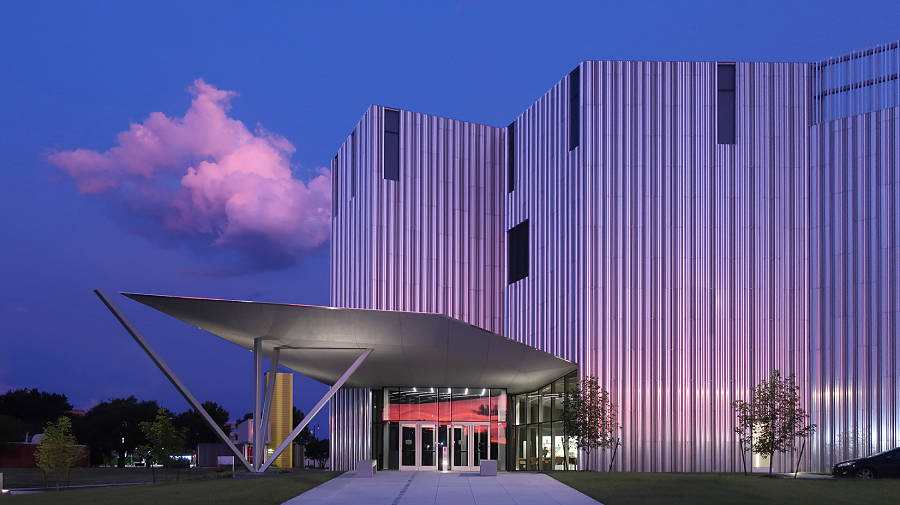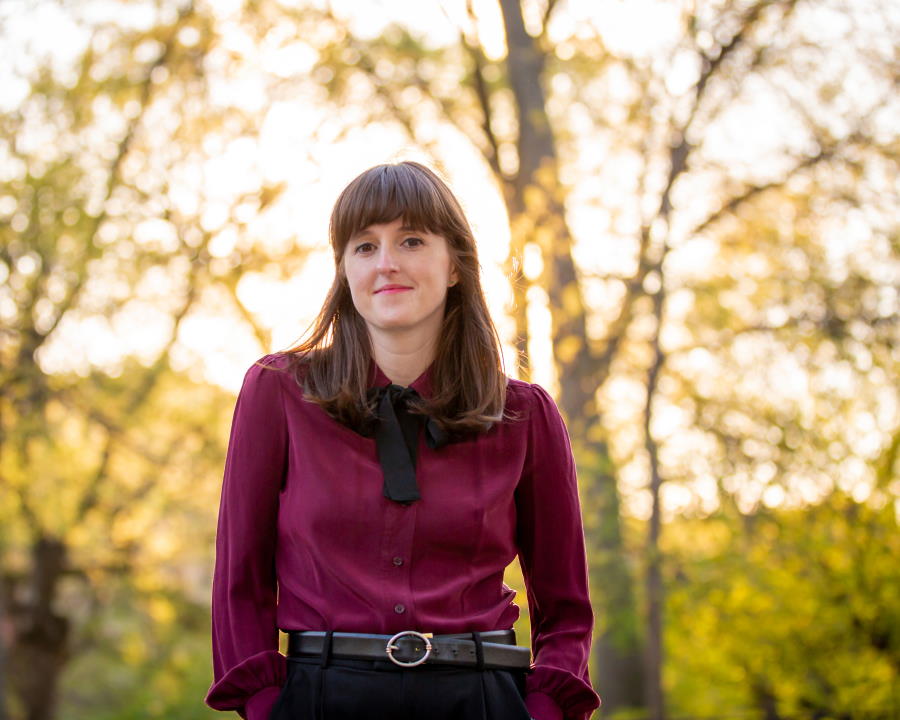It’s not exactly a homecoming for Kelly Kerwin, who hails originally from nearby Missouri, but in taking the job of artistic director at Oklahoma City Rep, she is back near the nation’s heartland after years in Chicago’s theatre scene, at Yale, and in New York City, where her work as an artistic producer centered around the Public Theater and its Under the Radar Festival.
The theatre is now in the midst of a “reboot season,” which started in January with Inua Ellams’s An Evening With an Immigrant and continues with James Harrison Monaco and JJJJJerome Ellis’s Piano Tales, as well as a “guided audio experience” called Of a Mind: Oklahoma City, scheduled to begin in May. It’s a modest start, but in a recent Zoom call, Kerwin outlined her plans for the $750,000 theatre, and gave me her impressions of her new hometown.
ROB WEINERT-KENDT: A belated congrats on the job. It’s been not quite a year, right?
KELLY KERWIN: My final interview was in March 2021, and then I moved here in July.
Your bio says you’re originally from the Ozarks. Can you be more specific?
I’m from Springfield, Mo., which is the Queen City of the Ozarks—that’s what people in the Ozarks say, which I think means it has a Bed Bath & Beyond.
How far is that from Oklahoma City?
You just take I-44. It’s quite an easy drive, about four-and-a-half hours, which in this part of the country isn’t that bad.
You built your theatre career elsewhere, mostly as a producer, is that right?
I trained specifically twice as a dramaturg, so I have an MFA in dramaturgy. So I’m fully ready to dramaturg! But as you know, there aren’t so many jobs in the dramaturgy world that aren’t in literary management. I had done some of that in between undergrad and grad school, but I really wanted to go into artistic producing.
Tell me more about this dramaturg/producer crossover. It’s something I see a lot of in the field, in particular at the Public, where you did a lot of work. What is it about a dramaturg that makes good producer and vice versa?
I think a dramaturg loves the work, loves the artists, and has a good understanding of what the work is trying to do. You’re trained to read something on a page and to try to understand where it will go in a production. So I think having that skill set, but also that passion—and every dramaturg I know has that passion, otherwise there’s no reason to study dramaturgy; otherwise go be a lawyer! So there’s this love and passion, but also this deep understanding of how a play can get from A to B to C to D. That works from a dramaturgical standpoint when you’re working with a playwright, but it also works when you’re zooming out and understanding, okay, here’s when the design team can come in, and if we don’t have this by the deadline, then the dominoes will fall and it will make problems. So how do we make the artistic process as smooth and as seamless and as wonderful for the artists as possible? The other aspect is that I think dramaturgs are generally quite good at managing personalities.
Tell me about Oklahoma City Rep. Obviously the summer of 2021 was a strange time to start running a theatre, right?
It was completely dark. It was the summer of 2020 when Donald Jordan announced he would be retiring. There weren’t any shows in the pipeline, or any brick-and-mortar space for the theatre. It really had gone into hibernation mode, and they were working on a leadership transition at the height of the pandemic.
Does that give you a sort of a blank slate going on?
I have used the term blank slate. The board is repopulated, newly energized. Now our board is at 11 people—when I was interviewing there were only five—and I also got to hire staff. There’s a new mission, new values, new everything. It really was a blank slate when I got here, which was one of the draws of the job.
The theatre was founded by a group of actors in 1998, led by Donald Jordan. Is there anything from his or their legacy that you feel you need to honor or learn from?
I think there was a passion to make a professional theatre in a part of the country that didn’t really have access to a professional theatre. That is what I’m also trying to carry forward, and how do we build on that foundation? He has different tastes than I have, and he went to different artists than I want to go after, so everything else is kind of different. But as far as really wanting to be a place that can be a home for artists and performers that can pay a living wage—and that’s really what I’m trying to push for, the living wage aspect of it all—that’s consistent.
You’re in the midst of what you’re calling your “reboot season.”
Yeah, our first show was in January, and someone was like, “It’s like you’re rebooting the theatre.” And then the joke became what we’re calling it.
You said there was no brick-and-mortar space when Don left, so where are you going to do your shows?
Thankfully, Oklahoma Contemporary, which is this brand new contemporary art center in the heart of downtown, which was set to open March 14, 2020, are finally open now. That’s where our first two “reboot” shows are, in a beautiful theatre space on the third floor of that building. The place is specifically called a contemporary art center, not a museum. It really is trying to be a home for not only visual art, but also for performance and for workshops and students. That is where we will be having all of our shows for the next season.

But I’m also doing what I’m calling a dual model: productions, the traditional way of doing theatre, where you hire actors and directors and you do a show, but also presentation of work, either international artists or foreign companies and foreign artists, similar to the kind of work that would be at Under the Radar, which is what I used to also produce. I’m kind of seeing the field going toward that—producing their own work, but also bringing in some of the amazing work that’s happening all over the country and all over the world. So we’ll have three presentations and three productions in our next season.
That sort of answers another question I had, about the extent to which you’ll bring in folks from your previous producing career, and the connections you made with your Under the Radar work, and with artists from your time in New York and Chicago.
That is the ultimate goal, to have this theatre in the middle of the country that presents amazing international work, but also is a theatre for Oklahoma City that features work created within Oklahoma City by artists here. What I was so moved by when I went in for my interview was that it is a very artistic city. I mean that in a very broad way. There’s a huge visual art scene and a huge music scene. The theatre scene is not as big, which is part of what I’m hoping to change. But I really do believe that theatre can come from people who don’t necessarily think of themselves as theatre artists. It can come from music—look at Hadestown. So I really am trying to galvanize the artists of Oklahoma City to see some of the stuff in the reboot; some of it’s created by poets or musicians, some of it’s created by sound designers or dramaturgs. And hopefully they get inspired and we can try to have some original pieces in Oklahoma City that might be more reflective of the kinds of outside-the-box work that is happening in our community.
Can you say more about your impressions of the city itself and where you live?
My husband and I live in the Montgomery building, which is an old Montgomery Ward that has been there for 100 years. So we feel when the tornado sirens go off, we’re in a fortunate spot.
It is a very diverse city in a way that I was delightfully surprised by. I’m from Springfield, Mo., which is not at all diverse. Not only is there a huge African American community and Latinx community here, there’s also a really big Vietnamese population, because this was one of the places after the Vietnam War where a lot of refugees came. And there’s the second highest population of Native Americans in the U.S.; 39 federally recognized tribes are in Oklahoma and are very active in Oklahoma. There’s a cowboy culture, and there’s a Black culture with Bass Reeves. It’s the 46th state, so it’s young, and the history is really fascinating. And I’ve also found that the people are really friendly. They’re really chatty. They’re ready to learn all about you.
Since you mentioned the region’s diversity, can you tell me how you plan to reflect that on your stage and behind the scenes?
I was at the Public during the summer of 2020, and thankfully the producing department there was majority women of color. So I had a very wonderful group of people who I could go through the We See You, White American Theater demands with and talk about, what can we do at the Public to try and make change? In trying to figure what I can do now, this theatre is relatively small, and much more nimble, so I feel like I actually have the freedom to do real things. I believe it’s not about baby steps. It’s about putting the work in action. The first meeting I had with my board, I said, “We’re a place for everyone, we’re a welcoming place, and we will pay a living wage, we’re not going to ask people to work for free.” I’ve been able to speak about that with my staff, with my artists, with the board, and with my audience. Those are the four that make the theatre; it’s not just the staff and the artists, it’s everyone. I’m really working to reflect onstage that have historically not been represented at this theatre in particular, and also in Oklahoma.
Are you optimistic about the future of not just your theatre, but theatre in general?
Yeah, I am. There have been so many new artistic directors taking over theatres, and I love so many people personally: Maria Goyanes at Woolly Mammoth, who hired me at the Public. Jacob Padron and I worked at Steppenwolf, Stephanie Ybarra I worked with at the Public. Ken-Matt Martin and I didn’t really meet until recently, but has been so supportive. He’s been like: “We are the millennial artistic directors, we have to stick together.”
And I feel that different kinds of thinkers are getting artistic director roles. I find that heartening, and I’m excited to see where the field goes. The support of the multihyphenate artist—I think that’s where the field is going. As much as I love new plays, I think we’ve been in that new-play world for about 20 years. What’s next?
You mentioned reaching out to musicians and other artists in town, so is that one direction you might go next?
Well, the Flaming Lips are from Oklahoma City, and I had a Flaming Lips poster in my bedroom growing up. I’ve heard they’re working on a musical…
Wait, is that your real agenda with this job? To get the Flaming Lips to work with you there?
If that happens, and if I can get Nature Theatre of Oklahoma to work here, I can die.





